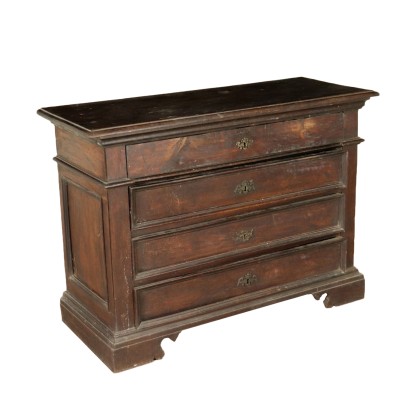Chest of Drawers Walnut Poplar Italy Early 1700s
Features
Age: 18th Century / 1701 - 1800
Origin: Centro Italia, Italy
Main essence: Walnut , Poplar
Material: Bronze , Iron , Solid Walnut
Description
A chest of drawers, solid walnut, four drawers. The upper one is smooth, the others enclosed in moldings. Bracket feet. Bronze plates with garlands and masks. Poplar interiors, original iron locks shaped like ace of cups. Manufactured in Italy, early 18th century.
Product Condition:
Fair condition. Wear consistent with age and use. Any damage or loss is displayed as completely as possible in the pictures.
Dimensions (cm):
Height: 105
Width: 128
Depth: 58
Additional Information
Age: 18th Century / 1701 - 1800
18th Century / 1701 - 1800 Main essence:
Walnut
Walnut wood comes from the plant whose botanical name is juglans regia , probably originally from the East but very common in Europe. Light or dark brown in color, it is a hard wood with a beautiful grain, widely used in antique furniture. It was the main essence in Italy throughout the Renaissance and later had a good diffusion in Europe, especially in England, until the advent of mahogany. It was used for solid wood furniture and sometimes carvings and inlays, its only big limitation is that it suffers a lot from woodworm. In France it was widely used more than anything else in the provinces. In the second half of the eighteenth century its use decreased significantly because mahogany and other exotic woods were preferred.
Poplar
Essence considered "poor", it is a white wood, with yellowish or greyish shades, light and tender, which is easily damaged. It is used for rustic furniture or in the construction of furniture. The most valuable use it has had in the history of furniture is in Germany, in the 19th century, for veneers and inlays in the Biedermeier period. Material:
Bronze
Iron
Solid Walnut

























